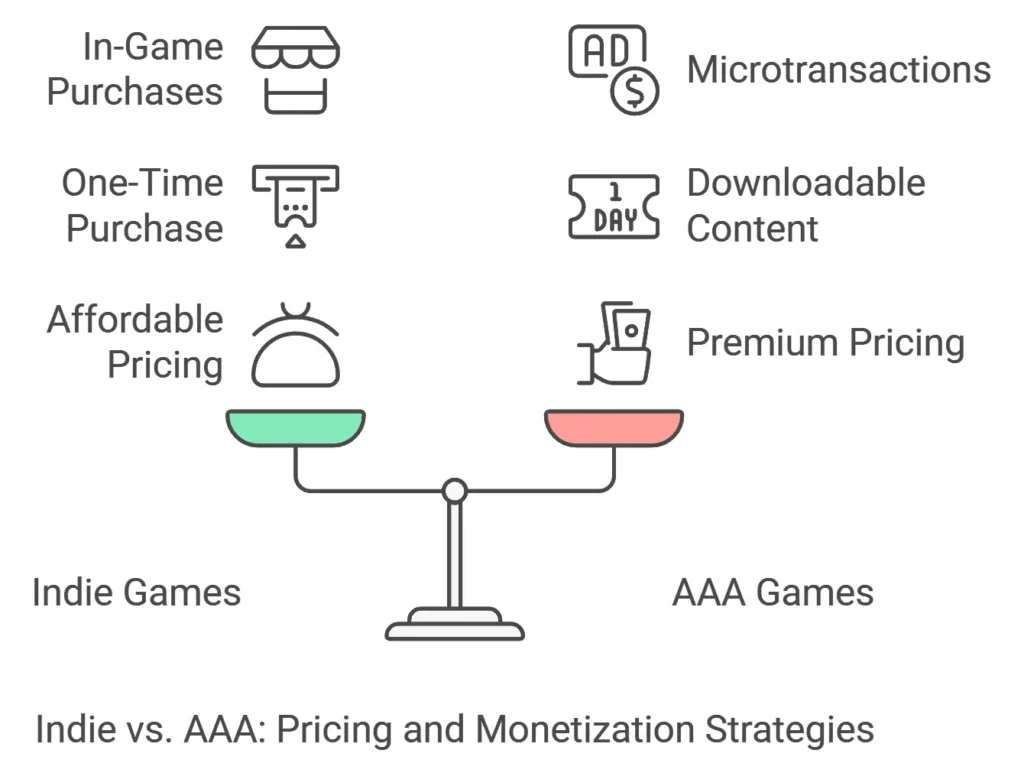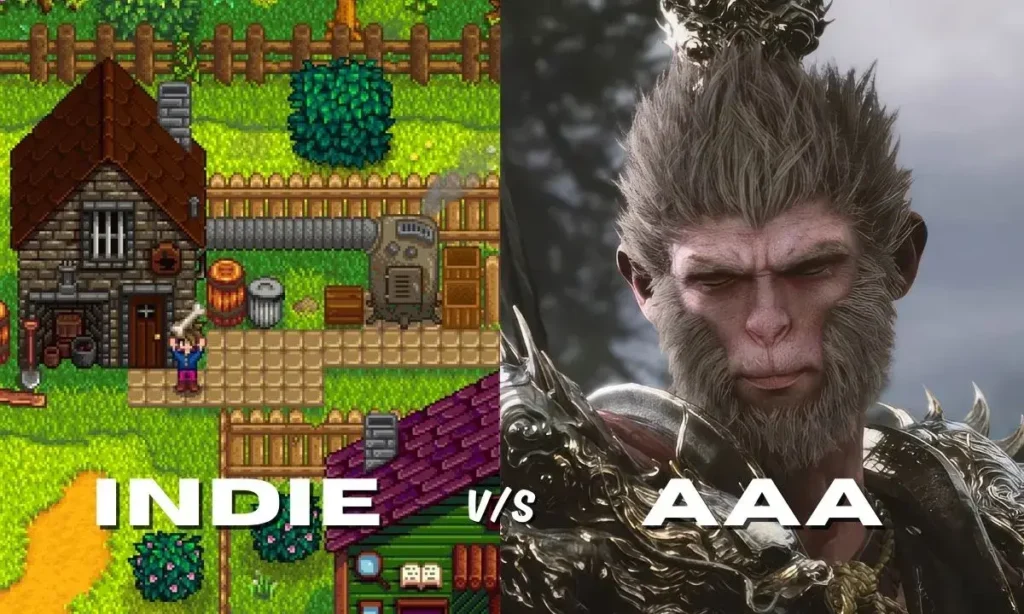The gaming industry has evolved remarkably over the past few decades, giving rise to diverse categories of games that cater to a wide range of audiences. Among these, Indie and AAA games stand out as two prominent classifications, each with its unique characteristics and contributions to the gaming landscape. Understanding the distinctions between these two categories is essential for gamers, developers, and industry enthusiasts alike.
Defining Indie and AAA Games
Indie Games:
- Definition: Indie games, short for independent games, are developed by individuals or small teams without the financial support of large publishers. These developers often rely on personal funds, crowdfunding, or small investors to bring their creative visions to life.
- Characteristics:
- Creative Freedom: Indie developers enjoy significant autonomy, allowing them to experiment with unique gameplay mechanics, art styles, and narratives.
- Limited Resources: Due to smaller budgets, indie games may not have the high-end graphics or extensive content found in larger titles, but they often compensate with innovative design and storytelling.
- Niche Appeal: Many indie games target specific audiences, exploring themes and genres that may be overlooked by mainstream developers.
AAA Games:
- Definition: AAA (Triple-A) games are high-budget titles produced by large studios with substantial financial backing from major publishers. These games aim for mass-market appeal and are often part of well-established franchises.
- Characteristics:
- High Production Values: AAA games feature cutting-edge graphics, professional voice acting, and expansive worlds, providing immersive experiences.
- Large Development Teams: Hundreds of professionals, including designers, programmers, artists, and marketers, collaborate to develop these titles.
- Extensive Marketing Campaigns: Significant resources are allocated to promote AAA games through advertisements, trailers, and events to maximize reach and sales.
Understanding these definitions sets the stage for a deeper exploration of the differences between indie and AAA games, encompassing aspects such as development processes, budgets, creative freedom, production quality, marketing strategies, pricing models, community engagement, market trends, and future outlooks.
Development Process and Team Structure
The development processes and team structures of Indie and AAA games differ significantly, reflecting their distinct approaches to game creation.
Indie Games:
- Development Process:
- Flexibility: Indie developers often adopt agile methodologies, allowing for rapid iteration and adaptation based on feedback.
- Prototyping: Emphasis is placed on creating prototypes to test core mechanics before full-scale development.
- Resource Management: With limited budgets, indie teams prioritize essential features and may utilize open-source tools to manage costs.
- Team Structure:
- Small Teams: Typically composed of a few individuals, where each member may handle multiple roles, such as programming, design, and marketing.
- Collaborative Environment: Close-knit teams facilitate open communication and swift decision-making.
- Outsourcing: Certain tasks, like sound design or art, may be outsourced to freelancers to fill skill gaps.
AAA Games:
- Development Process:
- Structured Workflow: Follows a well-defined production pipeline with distinct phases: pre-production, production, and post-production.
- Specialization: Teams consist of specialists focusing on specific aspects, such as level design, AI programming, or character modeling.
- Quality Assurance: Extensive testing phases are implemented to ensure a polished final product.
- Team Structure:
- Large Teams: Development teams can number in the hundreds, with clear hierarchies and departmental divisions.
- Cross-Disciplinary Collaboration: Departments like art, programming, and design work in tandem, often coordinated by producers or project managers.
- Global Collaboration: AAA studios may have multiple offices worldwide, requiring coordination across different time zones and cultures.
These contrasting development processes and team structures highlight the diverse approaches to game creation in the industry.
Budget and Funding
The financial frameworks supporting Indie and AAA games differ markedly, influencing their development scope, marketing strategies, and overall production quality.
Indie Games:
- Funding Sources:
- Personal Savings: Many indie developers self-fund their projects, investing personal finances to maintain creative control.
- Crowdfunding: Platforms like Kickstarter and Indiegogo enable developers to raise funds directly from future players, fostering a dedicated community early on.
- Grants and Indie Funds: Organizations such as Indie Fund provide financial support to promising indie projects, helping them reach completion.
- Budget Considerations:
- Development Costs: Budgets vary widely but are generally modest, often ranging from a few thousand to several hundred thousand dollars.
- Marketing Expenses: Limited funds necessitate cost-effective marketing strategies, relying heavily on social media and community engagement.
AAA Games:
- Funding Sources:
- Major Publishers: Large corporations like Electronic Arts, Ubisoft, and Activision Blizzard finance AAA titles, providing substantial budgets and resources.
- Investors: Investment firms may fund AAA projects, expecting significant returns upon the game’s release.
- Budget Considerations:
- Development Costs: AAA game budgets have escalated in recent years, with development costs often exceeding $200 million. For instance, the development budget for the next Call of Duty game has already surpassed $300 million.
- Marketing Expenses: Marketing budgets can rival or even surpass development costs, with some franchises allocating over $500 million to promote a single title.
These financial disparities underscore the contrasting scales at which Indie and AAA games operate, each with its unique challenges and advantages.
Creative Freedom and Innovation
The degree of creative freedom and capacity for innovation varies significantly between Indie and AAA game development, influencing the diversity and originality of the gaming experiences they offer.
Indie Games:
- Creative Autonomy:
- Unrestricted Vision: Indie developers often operate without external pressures, allowing them to pursue unique and personal creative visions.
- Experimental Gameplay: The flexibility to explore unconventional mechanics and narratives leads to innovative and diverse gaming experiences.
- Innovation:
- Genre Blending: Indie titles frequently combine elements from various genres, creating novel gameplay experiences.
- Risk-Taking: The lower financial stakes enable indie developers to take creative risks that might be untenable for larger studios.
AAA Games:
- Creative Constraints:
- Market Considerations: Significant financial investments necessitate a focus on mass-market appeal, which can limit experimental approaches.
- Franchise Continuity: Established franchises may adhere to proven formulas to meet fan expectations and ensure profitability.
- Innovation:
- Technological Advancements: AAA studios often push the boundaries of technology, incorporating cutting-edge graphics, physics, and AI to enhance realism.
- Incremental Innovation: While major overhauls are rare, AAA games may introduce new features or improvements within established frameworks.
These dynamics highlight how the scale and financial backing of a project can influence its creative direction and potential for innovation.
Production Quality and Graphics
The production quality and graphical fidelity of games are pivotal in shaping player experiences. Indie and AAA games differ significantly in these aspects due to variations in resources, team sizes, and development priorities.
Indie Games:
- Artistic Styles:
- Unique Visuals: Indie developers often employ distinctive art styles to set their games apart, utilizing techniques like pixel art, hand-drawn illustrations, or minimalist designs.
- Creative Expression: Limited budgets encourage innovative visual approaches, resulting in memorable aesthetics that resonate with niche audiences.
- Technical Aspects:
- Resource Management: With constrained resources, indie games may not achieve high-end graphics but focus on delivering engaging gameplay and storytelling.
- Performance Optimization: Simpler graphics can lead to smoother performance across various hardware configurations, broadening accessibility.
AAA Games:
- Graphical Fidelity:
- High-Definition Visuals: AAA titles leverage advanced technologies to deliver photorealistic graphics, immersive environments, and detailed character models.
- Cutting-Edge Techniques: Utilization of technologies like ray tracing, motion capture, and high-resolution textures enhances realism.
- Production Values:
- Extensive Resources: Large budgets and specialized teams enable meticulous attention to detail, resulting in polished and immersive experiences.
- Consistency and Quality: Standardized workflows and quality assurance processes ensure a high level of production quality across all aspects of the game.
These distinctions highlight how resource availability and development focus influence the visual and technical presentation of Indie and AAA games.
Marketing and Distribution
The strategies for marketing and distributing Indie and AAA games differ significantly, reflecting their distinct resources, target audiences, and market positions.
Indie Games:
- Marketing Strategies:
- Grassroots Marketing: Indie developers often rely on organic growth through social media engagement, community building, and word-of-mouth promotion. Platforms like Twitter, Reddit, and Discord are commonly used to connect with potential players.
- Content Creation: Developers share behind-the-scenes content, development diaries, and early demos to generate interest and foster a loyal community.
- Influencer Collaborations: Partnering with streamers and content creators can amplify reach without significant financial investment.
- Distribution Channels:
- Digital Platforms: Services like Steam, itch.io, and console marketplaces provide accessible avenues for indie game distribution.
- Direct Sales: Some developers sell games directly through their websites, allowing for greater revenue retention and direct customer relationships.
AAA Games:
- Marketing Strategies:
- Extensive Campaigns: AAA titles benefit from large-scale marketing efforts, including television commercials, online ads, and high-profile events.
- Esports Sponsorships: Sponsoring esports teams and tournaments enhances visibility and engagement within the gaming community.
- Cross-Promotions: Collaborations with other media franchises and brands expand reach and attract diverse audiences.
- Distribution Channels:
- Retail and Digital Sales: AAA games are distributed both physically in retail stores and digitally through platforms like PlayStation Network, Xbox Live, and Steam.
- Global Launches: Coordinated worldwide releases ensure simultaneous availability across major markets, maximizing initial sales impact.
These contrasting approaches underscore how resource availability and market positioning influence the marketing and distribution strategies of Indie and AAA games.
Pricing and Monetization
The approaches to pricing and monetization in Indie and AAA games differ significantly, reflecting their distinct development scales, target audiences, and revenue strategies.
Indie Games:
- Pricing Strategies:
- Affordable Pricing: Indie games are typically priced lower than AAA titles, often ranging from $5 to $20, making them accessible to a broader audience.
- Dynamic Pricing: Developers may adjust prices based on factors like game length, content depth, and market demand.
- Monetization Models:
- One-Time Purchase: A common model where players pay once to own the game, with no additional costs.
- In-Game Purchases: Some indie games offer optional in-game purchases, such as cosmetic items or expansions, to generate additional revenue.
- Freemium Model: Offering the base game for free with optional paid content or features.
AAA Games:
- Pricing Strategies:
- Premium Pricing: AAA titles are often priced at $60 to $70 at launch, reflecting their high development and marketing costs.
- Deluxe Editions: Offering higher-priced editions with additional content, such as art books, soundtracks, or in-game items.
- Monetization Models:
- Downloadable Content (DLC): Post-launch content expansions that players can purchase to enhance their gaming experience.
- Microtransactions: In-game purchases for cosmetic items, virtual currency, or other enhancements.
- Season Passes and Subscriptions: Offering access to a series of upcoming DLCs or exclusive content for a one-time fee or recurring subscription.

Community and Player Engagement
Community engagement plays a pivotal role in the success and longevity of both Indie and AAA games. However, the strategies and dynamics of interaction with players differ significantly between these two sectors.
Indie Games:
- Direct Developer Interaction:
- Personal Engagement: Indie developers often interact directly with their player base through platforms like Discord, Reddit, and Twitter, fostering a sense of community and accessibility.
- Feedback Integration: Player feedback is frequently incorporated into game updates and future projects, allowing the community to influence development.
- Community Building:
- Grassroots Initiatives: Indie games often rely on word-of-mouth and community-driven promotion, with players actively participating in spreading awareness.
- User-Generated Content: Encouraging mods, fan art, and other user-generated content helps sustain engagement and fosters a dedicated community.
AAA Games:
- Structured Community Management:
- Dedicated Teams: Large studios employ community managers and support staff to handle player interactions, feedback, and support.
- Official Channels: Engagement occurs through official forums, social media accounts, and in-game events, maintaining a professional and consistent communication strategy.
- Player Engagement Strategies:
- Live Services: Many AAA titles offer ongoing content updates, events, and expansions to keep the player base engaged over time.
- Esports and Competitive Play: Organizing tournaments and supporting competitive scenes enhances community involvement and extends the game’s lifespan.
These approaches highlight how Indie and AAA developers tailor their community engagement strategies to align with their resources, goals, and player expectations.
Market Trends and Industry Impact
The gaming industry is dynamic, with Indie and AAA games each influencing market trends and shaping the industry’s future.
Indie Games:
- Market Growth:
- Revenue Increase: In 2024, indie games generated nearly $4 billion in gross revenue on Steam, accounting for 48% of all full-game revenue on the platform.
- Rising Market Share: The indie segment’s revenue share has doubled since 2018, indicating significant growth and consumer interest.
- Industry Impact:
- Innovation Driver: Indie developers often introduce novel gameplay mechanics and narratives, pushing the boundaries of traditional game design.
- Platform Diversification: The success of indie titles has encouraged platforms like Steam and Epic Games Store to support and promote independent developers.
AAA Games:
- Market Trends:
- High Production Costs: AAA game development budgets have escalated, with some titles exceeding $200 million, reflecting the industry’s focus on high-quality, immersive experiences.
- Franchise Dominance: Established franchises continue to dominate sales, with sequels and spin-offs ensuring consistent revenue streams.
- Industry Impact:
- Technological Advancement: AAA studios invest heavily in cutting-edge technology, setting industry standards for graphics, physics, and AI.
- Market Saturation Concerns: The focus on blockbuster titles has led to concerns about market saturation and the potential stifling of creativity.
These trends highlight the evolving dynamics of the gaming industry, with both Indie and AAA games playing crucial roles in shaping its trajectory.
Future Outlook
The gaming industry is poised for continued evolution, with both Indie and AAA games adapting to emerging technologies and shifting consumer preferences.
Indie Games:
- Technological Advancements:
- Accessibility of Tools: The proliferation of user-friendly game development engines, such as Unity and Unreal Engine, empowers indie developers to create high-quality games with fewer resources.
- Cloud Gaming: Platforms like Google Stadia and NVIDIA GeForce Now offer indie games broader reach by reducing hardware limitations for players.
- Market Opportunities:
- Niche Markets: Indie developers are increasingly targeting underserved genres and themes, catering to specific player interests and fostering dedicated communities.
- Cross-Platform Play: Implementing cross-platform functionality allows indie games to reach wider audiences and enhance multiplayer experiences.
AAA Games:
- Technological Innovations:
- Virtual Reality (VR) and Augmented Reality (AR): AAA studios are investing in VR and AR technologies to create immersive gaming experiences.
- Artificial Intelligence: Advancements in AI are enabling more dynamic and responsive game worlds, enhancing player engagement.
- Industry Challenges:
- Rising Development Costs: Escalating budgets necessitate higher sales to achieve profitability, increasing financial risk.
- Market Saturation: The abundance of AAA titles may lead to market saturation, prompting studios to seek innovative approaches to stand out.
Final Thoughts
The gaming industry thrives on the diverse contributions of both indie and AAA games, each offering unique experiences that cater to a wide range of player preferences.
Indie games are celebrated for their creative freedom, allowing developers to explore unconventional narratives and innovative gameplay mechanics. This often leads to unique gaming experiences that resonate with niche audiences.
However, indie developers face challenges such as limited resources, which can restrict marketing reach and production quality, making it difficult to stand out in a crowded market.
On the other hand, AAA games benefit from substantial budgets, enabling cutting-edge graphics, expansive worlds, and polished gameplay. These high production values often set industry standards and appeal to a broad audience.
Nonetheless, the escalating development costs increase financial risk, and market pressures can lead to formulaic designs, potentially stifling innovation.
Understanding these distinctions allows players and industry stakeholders to appreciate the unique contributions of both sectors. As the industry continues to evolve, the interplay between indie and AAA games will shape the future of gaming, offering a rich tapestry of experiences for all.



